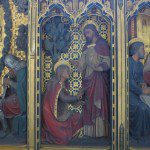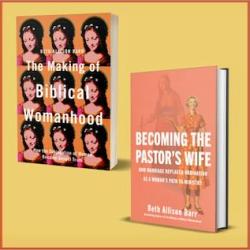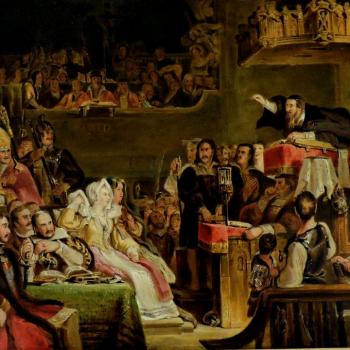Bruce Feiler has put Adam and Eve back in vogue with his book The First Love Story: Adam, Eve, and Us, reading that couple’s story as a classic–no, as the classic love story. For Feiler it is not just classic but useful, the pair as role models for relationships today. He thinks theirs is a great love story because it is a tale told together, from what he calls the first “meet cute” to the joint, “long term practice of reinvention, reconciliation, and renewal.” Feiler argues that Adam and Eve still can matter to us, as a couple, to help correct our fragmentation and difficulties in romantic partnerships. He emphasizes their equality, their intended mutual help, and the blooming of their love through the difficulties that attended their expulsion from paradise and the misbehavior of their offspring.
Seeing Adam and Eve on the ceiling of the Sistine Chapel, Feiler wonders if this old story still has anything to tell us. That’s not a hard question here: in addition to my occupational assumption, that old stories pretty much always have something to tell us, a few reasons make the Adam and Eve account perennially relevant. The story bears on our understanding of creation, of the nature of men and women and their relationship to each other and, indeed, humans’ relation to the rest of the animal, vegetable, and mineral world.
So we should not find it strange if the story has been revived and reinterpreted over and over again. Imaginative interpretation can make for some odd conclusions though, like Feiler’s interpretation of the fateful apple-eating, which he reads as good for self-assertion and sharing. In promotions for the book Feiler suggests that Eve wanders off on her own in the garden because she is unhappy and “doesn’t want to be a subset of Adam. That prompts her going into the garden alone, and eating the fruit. She thinks, ‘If I’m just an appendage of him, this relationship is not going to work. I need to have a voice and knowledge.’” But then she rethinks it. Though “she could be like, ‘I can keep it all to myself,’” she returns to Adam and gives him some, and and he, though recognizing the act as wrong, “asks himself, ‘Do I choose obligation and duty? Or do I choose companionship?’” That, for Feiler, is “the most romantic moment of the story.” My own sense is that that makes rather light of the violation, which is not just about “obligation and duty.” It lays a little too much stress on the happy part of the felix culpa and for the wrong bit of happiness, since the act chooses against companionship with the divine.
Feiler’s analysis does not do heavy-duty church history. For example, naming the culprit that squandered an egalitarian account of human origins, Feiler answers, “organized religion got a hold of the story. And by organized religion, of course, I mean men.” But his work profitably does remind us of two things: the long resonance of this text and the capacity of interpretations to reflect the priorities of those who make them.
Adam and Eve can be refashioned, a little like paper dolls who, punched out of cardboard and set on their stands, get period costumes pasted onto their ideal forms by every people and tribe that handle them. One of the most interesting ways of handling them, apropos of this year’s commemorations of Martin Luther, is the view provided by Kathleen M. Crowther‘s Adam and Eve in the Protestant Reformation.
Of course, Adam and Eve were not actually present in sixteenth-century Germany, though Crowther’s title illustrates well how a period’s emphases of thought and circumstance can drive interpretation of a text. Crowther argues that Lutherans reversed some conventions about Adam and Eve typical of medieval Catholicism. Whereas earlier portrayals often featured Eve as the weak and guilty party, responsible for the sufferings of all who proceeded from her, Crowther shows how Lutherans’ “Framing of Eve” rehabilitated the first woman. That bumper sticker slogan, that “Eve Was Framed,” has been embraced by some; Feiler for his part claims, “Eve is victim to the greatest character assassination the world has ever known.” But Crowther shows something quite different in these writers, who elevated Eve as a model woman, on level with Mary in some respects. In Lutheran teaching Eve remained subordinate to Adam–since she was made second, since she was designated as his helper, and since she was responsible for that big mistake–but she also got praised as an “extremely beautiful, marvelous, well-adorned maiden,” “full of all feminine honor and virtue,” as a good wife, mother, and housekeeper. Crowther argues that some Lutheran writers took cues on human nature from Eve more than from Adam: “it was Eve, not Adam, who represented and symbolized human nature after the Fall for sixteenth-century Lutherans.” Crowther is careful not to characterize this as a full-fledged elevation of women, given Lutherans’ “darker and more pessimistic” views of human nature. But this is a more positive appraisal, this Eve, working with Adam in a world where both body and soul, of men and women, are disordered and subject to decay.
Like Feiler, Crowther recognizes that the story does not end with an angel’s flaming sword barring the gate to paradise. Sixteenth-century texts took the story further and pictured postlapsarian Adam and Eve as having a flourishing domestic life after the Fall. Their story is about marriage, which Lutherans sermons extol as “the oldest and holiest estate,” as well as the responsible exercise of parenthood and the right ordering of society. Reformation writers picked up on earlier traditions of drama about the long lives of Adam and Eve. In Lutheran revisions of these medieval stories, what happens to the (un)happy couple out of Eden is that they have a bunch of kids whom they set to work and faithfully educate. At its most elaborate, the story is framed in a “catechism legend.” Crowther recounts several of these, for example Arnold Quiting’s 1591 play Kinderzucht, wherein one special Sabbath Day, God comes in person to conduct a catechetical examination. Adam, Eve, and some of their many children answer correctly, admitting that they are saved by grace through faith and not through works. In another version, the “charming” story narrated by Philip Melanchthon to Count Johann von Wied in 1539, when God comes to visit and comfort the first couple,
“Eve is in the middle of bathing the children when she looks out the window and sees God and a company of angels approaching. Realizing that she will not have enough time to clean up all her children before God and the angels arrive, she quickly hides the unwashed children in the hay and straw. She tells the clean children to stand in a row to await God’s entrance into their house and to bow and extend their right hands to Him in greeting when He enters. The children greet God respectfully, and God praises Eve for instructing them so well in good manners. Yet He also wants to know if she has taught them more important things, namely about God and religious doctrine. Eve assures Him that she has and invites God to question the children, starting with Abel, about what they believe. Abel answers by giving a concise account of the creation, the Fall, the promise of salvation through Jesus Christ, and the expectation of eternal life.”
Abel and some siblings honorably demonstrate their mastery of right doctrine. Others fail. In these stories Cain, drunken, loutish, dirty, and obstreperous, is assigned not only wrong or garbled answers but is used to illustrate error of Catholic doctrine, or worse, amalgamations of Catholicism, paganism, and blasphemy. Many Lutheran priorities, from belief in salvation by grace through faith, to the importance and goodness of family life, to respect for social order and appropriate obedience to authority, all are put on display in these narratives.
Since the first few chapters of Genesis speak to a doctrine of creation, as well as to sex, inequality, and family life, sixteenth-century writers treated also these topics in their revisionist accounts of Adam and Eve. Crowther shows the way the creation of human beings was reimagined as a kind of craft work, God using his hands to mold Adam from dirt. Furthermore, nature at large was given a Lutheran spin, plants and animals bespeaking the glory, wisdom, and kindness of God, though also marked through the Fall as mysterious and threatening. These writers also were fascinated by anatomy, and in the case of the human body, “tension between sexuality and sanctity remains unresolved.”
Crowther shows this tension most strikingly in her treatment of childbearing. Lutherans saw in a woman’s pregnancy a reprise of the original work of creation: “Procreation was thereby invested with cosmic significance. The gradual swelling of belly of a pregnant woman made God’s creative power visible and visceral.” That’s right, each big-bellied woman awaiting a baby witnessed–experienced in her own person and showed forth to others–an event of the same kind and power as the making of the whole universe. Lutherans saw Fall and redemption brought into focus in the sometimes perilous experience of childbirth in the sixteenth century. That is actually what happens, sons of Adam and daughters of Eve. We are still living in it, because the creation story is not over. That is the insight that intrigues, in the way sixteenth century Lutherans puzzled over the loss of paradise and the homemaking of first man and woman. There are many ways to read Genesis, and those Protestants’ efforts to make sense of the stories in some ways resemble what Feiler is trying to do: recognize the tenacity of those words and the wisdom of sticking with them, of recognizing that they yet have something to say to us, to you, even now.
Finally, what these stories have to teach us is not only what is in their recorded text, but what is to be learned through the interpretations made by others. Those reinterpretations form a common stock of meanings, even among their contradictions, a heritage which we claim or correct by knowing the text and considering afresh what we can make of it.














